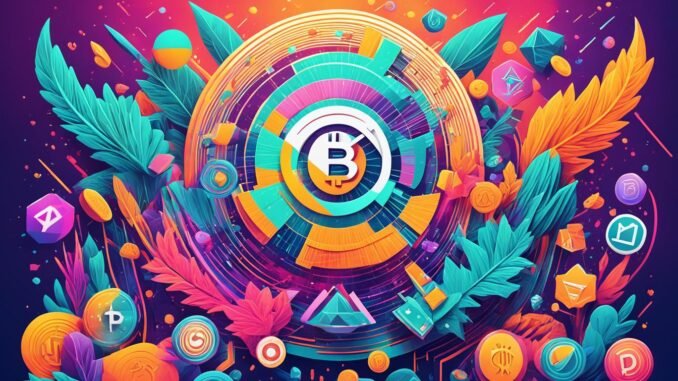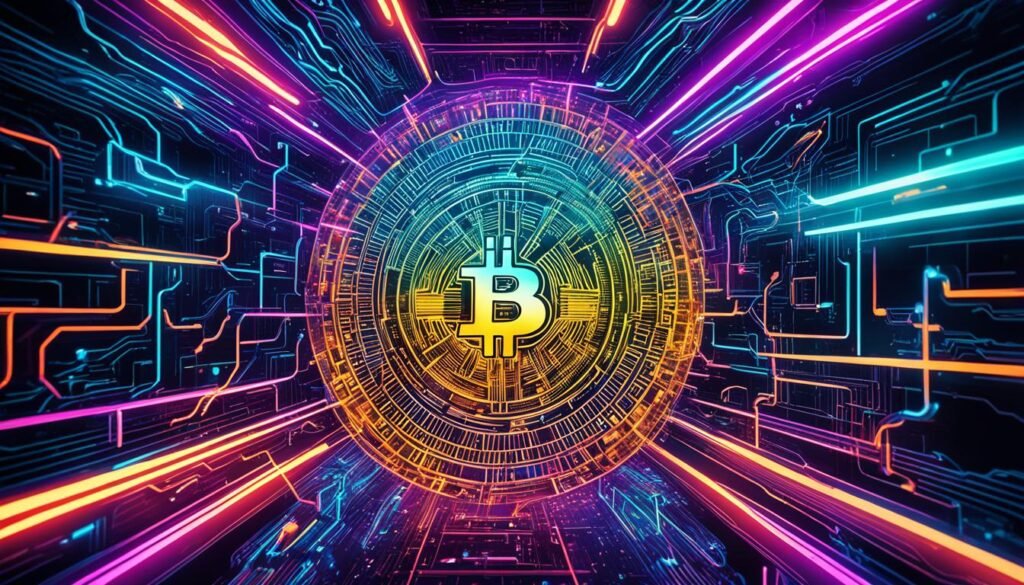
Did you know that a digital artwork sold for a staggering $69 million? This eye-popping sale made headlines and showcased the growing popularity of crypto art, a revolutionary form of artistic expression that combines technology and creativity. Crypto art leverages blockchain technology, specifically non-fungible tokens (NFTs), to create, authenticate, and trade digital collectibles.
With the rise of blockchain technology in the early 2010s, crypto art emerged as a unique way for artists to showcase their work and connect with a global audience. Blockchain, a decentralized and secure ledger, provides a transparent and immutable record of transactions, ensuring the authenticity and provenance of each digital artwork. NFTs, representing ownership of a specific artwork, are created using smart contracts on blockchain platforms like Ethereum.

Key Takeaways:
- Crypto art combines technology and creativity to create, authenticate, and trade digital collectibles.
- Blockchain technology and non-fungible tokens (NFTs) play a pivotal role in the creation and verification of crypto art.
- Crypto art provides artists with new avenues for exposure and income.
- NFTs redefine ownership dynamics, allowing collectors to truly own a digital piece of art.
- Despite challenges, the future of crypto art looks promising as it reshapes the art world and redefines artistic expression.
The Genesis and Technology of Crypto Art
The genesis of crypto art can be traced back to the early 2010s when artists and visionaries saw the potential to merge the worlds of art and blockchain technology. With the rise of Bitcoin and the advent of pioneering platforms like Ethereum, the stage was set for a new era of artistic expression.
At the core of crypto art lies blockchain technology, a decentralized and secure ledger that records transactions transparently and unchangeably. This revolutionary technology provides the foundation for the creation, validation, and trading of digital artworks.
The introduction of smart contracts on blockchain platforms such as Ethereum was a game-changer for the crypto art world. Smart contracts allow artists to create and manage non-fungible tokens (NFTs), which have become the cornerstone of the crypto art movement. Each NFT acts as a unique digital asset that represents ownership of a specific artwork. It serves as a digital certificate of authenticity, ensuring the originality and provenance of the artwork.
In the words of renowned crypto artist Beeple, “Crypto art is the biggest technological revolution within art since photography was invented.”
The marriage of blockchain and crypto art addresses one of the biggest challenges in the digital realm: provenance. By leveraging the immutability and transparency of blockchain technology, crypto art provides a solution to the longstanding issue of digital duplication and unauthorized distribution.

Innovation In Action: The Power of Smart Contracts
To better understand the role of smart contracts in the crypto art ecosystem, let’s dive deeper into their functionality.
Smart contracts are self-executing contracts with the terms of the agreement written directly into their code. These contracts automate the execution of specific actions when predetermined conditions are met. For example, when an art collector purchases an NFT, the smart contract automatically transfers ownership of the digital artwork to the buyer and ensures that the original artist receives royalties from secondary sales.
| Benefits of Smart Contracts in Crypto Art | Examples |
|---|---|
| Transparent and Trustworthy Transactions | Verifiable ownership and transaction history |
| Automated Royalty Payments | Artists receiving a percentage of secondary sales |
| Efficient Art Verification | Certificate of authenticity embedded in the NFT |
| Immutable Ownership Records | Protection against copyright infringement and unauthorized copying |
The table above showcases the tangible benefits that smart contracts bring to the crypto art landscape. From ensuring transparent and trustworthy transactions to providing artists with a sustainable revenue stream, smart contracts revolutionize the way artists create, sell, and protect their digital artworks.
Now that we’ve explored the genesis and technology behind crypto art, it’s time to delve into how this innovative movement has empowered artists and redefined the concept of ownership. Stay tuned for Section 3!
Empowering Artists and Redefining Ownership
Crypto art has transformed the art world, offering artists unprecedented opportunities for exposure and income. Traditionally, artists faced numerous challenges such as copyright infringement and limited control over their work once it left their hands. However, the rise of crypto art, powered by NFTs, has revolutionized the concept of ownership, granting artists a newfound level of control and financial stability.
With NFTs, artists can retain ownership rights and receive royalties on secondary sales, ensuring a continuous and sustainable income stream. This provides a significant departure from the traditional art market, where artists often struggle to navigate complex licensing agreements and compensation structures.
The emergence of crypto art challenges the traditional notion of ownership in the art world. Through NFTs, collectors are now able to truly own a digital piece of art, with blockchain technology ensuring the authenticity and provenance of each artwork. This paradigm shift offers both artists and collectors a new level of confidence and trust in the digital art market.
Furthermore, crypto art breaks away from the traditional gallery-centric model of the art world, allowing artists to connect directly with their audience. Digital platforms provide a global reach and instant access, enabling artists to showcase their creations without the limitations of physical exhibitions.
Transforming the Relationship Between Artists and Collectors
The direct connection between artists and collectors facilitated by crypto art fosters a more intimate and collaborative environment. Artists can establish personal relationships with their audience, engage in meaningful conversations, and gain valuable feedback. This level of interaction is unparalleled in the traditional art market, where intermediaries often control communication and limit artist-collector interactions.
Moreover, the decentralized nature of the crypto art market expands opportunities for emerging artists to gain recognition and monetize their work. Traditional barriers such as geographical location and gallery representation no longer hinder artists from reaching a larger audience. Crypto art provides a level playing field, where artistic merit and innovation are paramount.
Crypto art has undoubtedly empowered artists by offering alternative means of income and enabling them to redefine the boundaries of ownership. As the crypto art market continues to mature and evolve, it offers exciting possibilities for artists to shape their careers and forge direct connections with their audience.

The Crypto Art Advantage: Financial Sustainability and Creative Freedom
One of the most significant advantages of crypto art lies in its ability to provide sustainable financial opportunities for artists. With NFTs and smart contracts, artists can receive royalties on all subsequent sales of their artwork, ensuring a continuous stream of income that extends beyond the initial purchase.
This royalty system revolutionizes the traditional art market, where artists often receive no compensation when their work appreciates in value over time. The ability to earn royalties allows artists to support their careers, invest in their creative process, and develop their practice over time.
Furthermore, crypto art frees artists from the constraints imposed by traditional galleries and art institutions. They are no longer limited by the requirements and preferences of curators, enabling them to explore innovative ideas and experiment with new mediums without compromising their creative vision.
Embracing the Future: The Role of Crypto Art in the Art Market
In an increasingly digital world, crypto art offers a glimpse into the future of the art market. It challenges the traditional art market’s exclusivity and elitism, making art more accessible and democratic. By leveraging blockchain technology and decentralization, crypto art opens doors for artists from all backgrounds, giving them the opportunity to thrive and find their unique creative voice.
Crypto art also pushes the boundaries of artistic expression, allowing artists to explore new possibilities in the digital realm. It encourages experimentation, cross-disciplinary collaborations, and the fusion of art, technology, and innovation.
While the traditional art market will always hold significance, crypto art represents an exciting and rapidly growing sector that redefines ownership, empowers artists, and democratizes the art world. Artists and collectors alike can embrace this transformative movement to shape the future of art, ownership, and creativity.
Challenges and Controversies Surrounding Crypto Art
While crypto art presents exciting opportunities, it has also faced challenges and controversies. Environmental concerns related to the energy consumption of blockchain networks, particularly in proof-of-work systems, have sparked debates about the sustainability of crypto art. Additionally, issues surrounding copyright infringement and the potential for artwashing are areas that the crypto art community grapples with. It is important for the crypto art community to address these challenges and find sustainable solutions to ensure the long-term viability of the industry.
Environmental Concerns
One of the key criticisms of crypto art revolves around its environmental impact. The energy consumption associated with blockchain networks used in crypto art creation and transactions, especially in proof-of-work systems like Bitcoin, has raised concerns about the carbon footprint of the industry. Critics argue that the energy consumption required for mining and validating transactions is unsustainable, exacerbating the global climate crisis.
However, proponents of crypto art argue that the industry is actively exploring alternative technologies and blockchain platforms with lower energy consumption, such as proof-of-stake systems like Ethereum 2.0. The transition to more energy-efficient solutions is crucial for addressing the environmental concerns associated with crypto art.
Copyright Infringement
Crypto art has also faced challenges concerning copyright infringement. The ease of digitally reproducing and distributing artworks has raised concerns about artists’ rights and the unauthorized use of their creations. Despite blockchain’s potential to establish provenance and ensure authenticity, the digital nature of crypto art poses unique challenges in terms of infringement monitoring and protection.
Artists, platforms, and the crypto art community as a whole are working together to tackle copyright infringement through strategies such as watermarking, tracking licenses, and issuing take-down notices for unauthorized copies. Building a robust framework for protecting intellectual property rights in the crypto art ecosystem is essential to ensure fair compensation for artists and to maintain the integrity of the industry.
The digital nature of crypto art presents new challenges in terms of copyright infringement and protecting artists’ rights. The crypto art community must work diligently to establish effective mechanisms for monitoring and enforcing intellectual property rights, ensuring artists receive proper compensation for their creations.
Artwashing
Artwashing refers to the practice of using crypto art as a means to legitimize questionable or unethical activities. Some critics argue that crypto art can be used as a tool to whitewash the reputation of individuals or organizations involved in illicit or controversial practices. The lack of transparency in the crypto art market and the anonymity of transactions have raised concerns about the potential for artwashing and money laundering.
To mitigate the risks of artwashing, the crypto art community is advocating for greater transparency, accountability, and regulation within the industry. Enforcing stricter Know Your Customer (KYC) and Anti-Money Laundering (AML) measures can help ensure that crypto art platforms are not unwittingly involved in artwashing practices.
Comparison of Challenges and Controversies in Crypto Art
| Challenges | Description |
|---|---|
| Environmental concerns | Debates around the energy consumption of blockchain networks and its impact on the environment. |
| Copyright infringement | Issues related to the unauthorized use and distribution of artists’ works in the digital realm. |
| Artwashing | The potential for crypto art to be used as a means of legitimizing questionable practices. |
The challenges and controversies surrounding crypto art highlight the need for ongoing dialogue, collaboration, and innovation within the industry. By addressing environmental concerns, strengthening copyright protection measures, and combating artwashing, the crypto art community can ensure the long-term viability and positive impact of this transformative form of artistic expression.
The Future of Crypto Art
As the world witnesses the continued growth of crypto art, it becomes clear that this innovative form of artistic expression is here to stay. Crypto art’s ability to redefine ownership, empower artists, and challenge the status quo makes it a compelling force in the ever-changing landscape of the digital age.
Blockchain technology, the foundation of crypto art, enables secure and transparent ownership, offering artists and collectors new possibilities for artistic expression and financial opportunities. With blockchain’s decentralized nature, crypto art challenges the traditional art market’s gatekeepers, giving artists greater agency in showcasing their work and connecting directly with their audience.
“Crypto art represents a paradigm shift that will continue to shape the future of artistic expression in the years to come.”
The ownership dynamics of crypto art are transforming the art market. Through the use of non-fungible tokens (NFTs), collectors can truly own a digital piece of art, guaranteeing its authenticity and provenance. This ensures that artists are properly rewarded for their creations, as they receive royalties on secondary sales. This shift in ownership allows artists to have a sustainable income stream and establishes a more equitable relationship between artists and collectors.
Furthermore, vibrant communities are forming around crypto art, creating a social and collaborative environment for artists and enthusiasts alike. Online platforms and marketplaces provide spaces for artists to showcase their work, collaborate on projects, and engage with a global audience. These communities foster creativity, inspire new ideas, and encourage artistic growth.
The future of crypto art promises a continuation of its transformative impact on artistic expression and the art market. As technology advances and the potential for virtual and augmented reality integration expands, artists will have even more tools at their disposal. The boundaries of artistic expression will be pushed further, creating immersive and interactive experiences for art enthusiasts.
Crypto art’s disruptive nature and potential for innovation pave the way for a future where artists have greater control over their work, the art market becomes more inclusive, and collectors directly support artists they admire. The continued growth and evolution of crypto art will shape the future of the art industry, creating exciting possibilities for both artists and art lovers.
| Benefits of Crypto Art | Challenges of Crypto Art |
|---|---|
| 1. Redefines ownership dynamics | 1. Environmental concerns related to energy consumption |
| 2. Empowers artists with control and royalties | 2. Copyright infringement |
| 3. Provides artists with exposure and income opportunities | 3. Potential for artwashing |
| 4. Fosters vibrant communities around art |
The Benefits and Challenges
The table above highlights some of the benefits and challenges associated with crypto art. While there are exciting opportunities for artists and collectors, there are also environmental concerns, copyright infringement issues, and the potential for artwashing. It is essential for the crypto art community to address these challenges and work towards sustainable solutions that address the concerns and criticisms.
Conclusion
Crypto art has sparked a revolution in the art industry, merging technology and creativity to empower artists and reshape the traditional art market. By leveraging blockchain technology and embracing the possibilities of the digital age, crypto art has opened new avenues for artists to showcase their work and connect directly with their audience. The redefined ownership dynamics offered by non-fungible tokens (NFTs) have challenged the conventional notions of owning art, allowing collectors to truly possess a digital masterpiece.
Despite facing challenges and controversies, including environmental concerns and issues of copyright infringement, the cultural impact of crypto art cannot be denied. As technology continues to evolve, so too will crypto art, bringing forth further innovations and developments that will transform the way we perceive, value, and interact with art. The future of crypto art holds great promise, with artists exploring new frontiers and pushing the boundaries of artistic expression.
Looking ahead, we can expect the continued growth and integration of crypto art into the art industry. As more collectors and institutions recognize the value of digital art and embrace the technological advancements, the landscape of the art world will be forever changed. The fusion of crypto art, technology, and the art industry opens up endless possibilities for artists to thrive and for audiences to engage with art in exciting new ways. The future is bright for crypto art, as it continues to shape our artistic landscape and inspire the next generation of creators.
FAQ
What is crypto art?
Crypto art is a form of artistic expression that leverages blockchain technology and cryptocurrency to create, authenticate, and trade digital artworks.
How does crypto art work?
Crypto art works by using blockchain technology to create non-fungible tokens (NFTs) that represent ownership of a specific artwork. These NFTs are created using smart contracts on platforms like Ethereum.
What is the benefit of crypto art for artists?
Crypto art empowers artists by providing them with new avenues for exposure and income. It allows artists to retain control over their work and receive royalties on secondary sales.
How does crypto art redefine ownership?
Crypto art redefines ownership by allowing collectors to truly own a digital piece of art through an NFT. This shifts the traditional ownership dynamics in the art market.
What are the challenges and controversies surrounding crypto art?
Some challenges and controversies surrounding crypto art include environmental concerns related to the energy consumption of blockchain networks, copyright infringement issues, and the potential for artwashing.
What does the future hold for crypto art?
The future of crypto art looks promising as it continues to reshape the art world and redefine artistic expression. It holds potential for greater agency for artists and a more direct connection with their audience. Follow the latest up to date crypto news at www.kryptogainz.com.




Be the first to comment